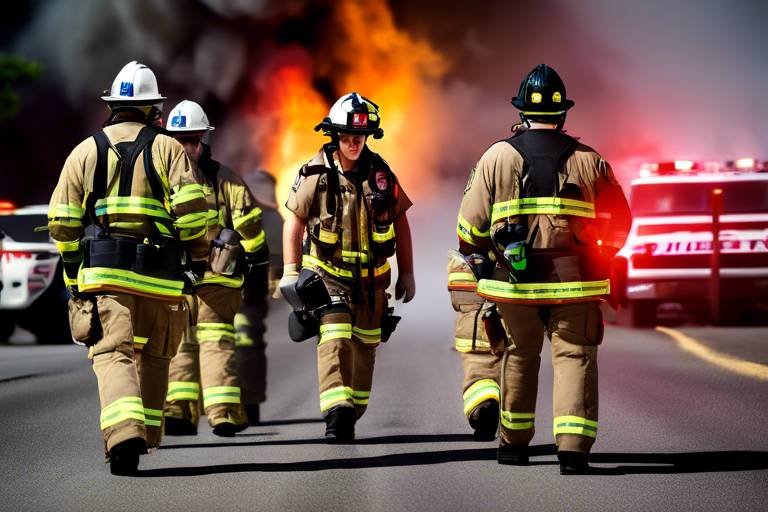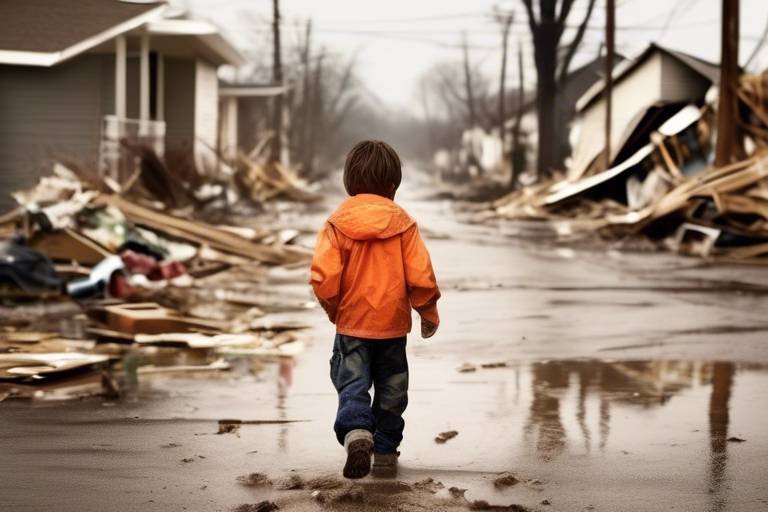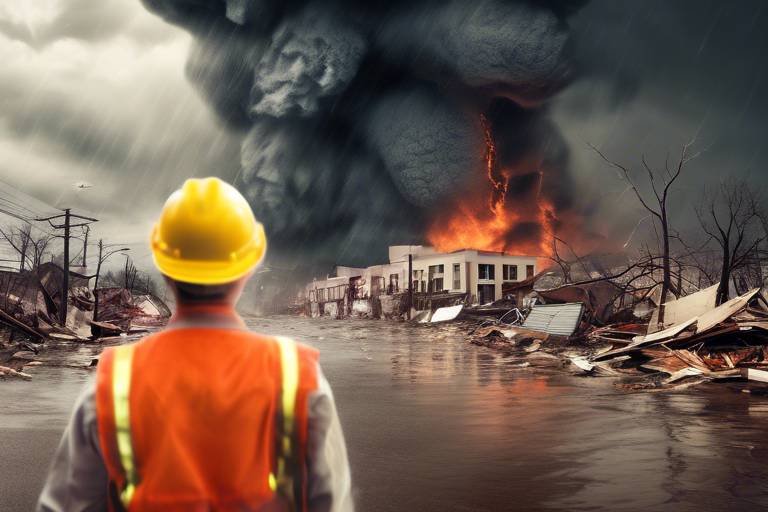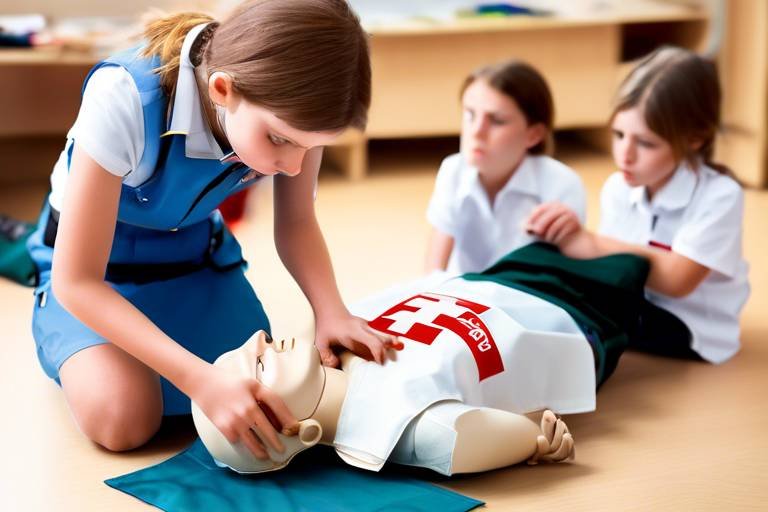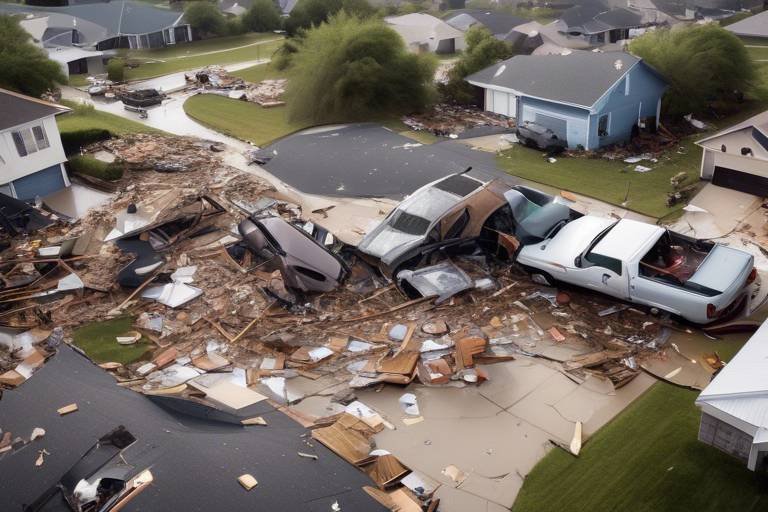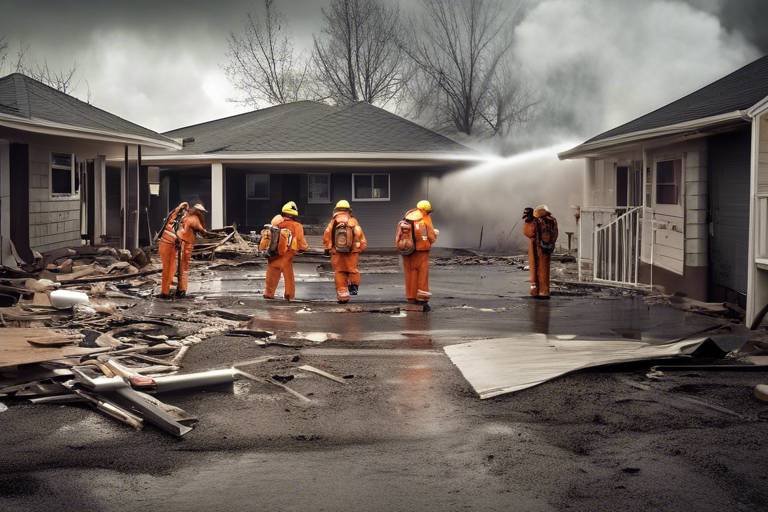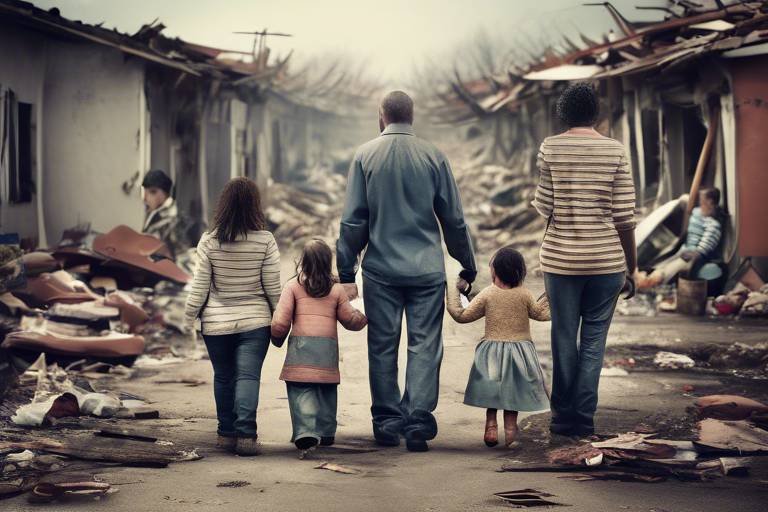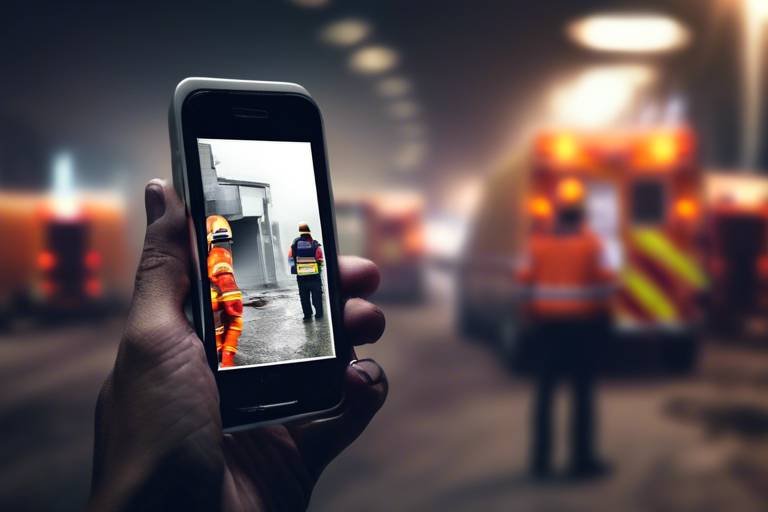Keeping Emergency Documentation – What You Need to Know
In a world where unpredictability is the only constant, keeping emergency documentation is not just a wise choice; it’s a necessity. Imagine being in a crisis—whether it's a natural disaster, a medical emergency, or any unforeseen event—and not having the crucial information at your fingertips. It’s like trying to find a needle in a haystack while the haystack is on fire! This article dives deep into the significance of maintaining emergency documentation, the types of documents you need, and practical tips to ensure you can access them when it matters most. By understanding these elements, you can significantly enhance your preparedness and response effectiveness, potentially saving lives and streamlining recovery efforts.
Emergency documentation plays a pivotal role in effective disaster response. Think of it as your personal lifeline during a crisis. It ensures that vital information is readily available, enabling quick decision-making and resource allocation when every second counts. For instance, having your medical records accessible can mean the difference between life and death in a medical emergency. When first responders arrive, they need to know your medical history, allergies, and medications. Without this information, they may struggle to provide the right care, which could lead to dire consequences. Understanding the significance of emergency documentation can not only save lives but also streamline recovery efforts, making it easier to navigate the chaos that often accompanies emergencies.
When it comes to emergency preparedness, various documents are essential. These include medical records, identification, and insurance information. Knowing what to gather and maintain can significantly impact your ability to respond effectively in an emergency situation. Here’s a quick overview of the types of documents you should consider:
- Medical Records: These are critical for ensuring proper care during emergencies.
- Identification Documents: Driver's licenses, passports, and other forms of ID are crucial for proving your identity.
- Insurance Information: This includes health insurance policies, homeowner's insurance, and any other relevant coverage.
Keeping updated medical records is vital for ensuring proper care during emergencies. These records provide healthcare professionals with crucial information about your allergies, medications, and medical history, facilitating timely and appropriate treatment. Imagine being unconscious during a medical emergency; your records could be the key to saving your life. They allow first responders to make informed decisions quickly, ensuring you receive the right care without unnecessary delays.
Your personal health information should include details about chronic conditions, medications, and emergency contacts. This information is essential for first responders and healthcare providers in delivering effective care during emergencies. For example, if you have a chronic condition like diabetes, it’s vital that medical personnel are aware of it immediately. Keeping this information accessible can help them provide the right treatment without wasting precious time.
Vaccination records are important for verifying immunizations, especially during outbreaks or in shelters. Keeping these records accessible ensures that individuals receive the necessary protection against contagious diseases in emergency situations. In a crisis, you might find yourself in close quarters with others, and having proof of your vaccinations can help protect you and those around you from potential health risks.
Identification documents, such as driver's licenses and passports, are crucial for proving your identity during emergencies. Having these documents readily available can help facilitate access to services and resources when needed. For instance, if you need to evacuate and seek shelter, being able to present your ID can expedite the process, allowing you to focus on what truly matters—your safety.
Proper organization of emergency documentation is key to effective emergency response. Implementing a systematic approach ensures that essential information is easily accessible, reducing stress during critical times. Picture this: you’re in the middle of an emergency, and you need to find your medical records. If they’re scattered across various locations or formats, it can create chaos. Instead, having a well-organized system—whether digital or physical—can make all the difference.
Deciding between digital and physical copies of emergency documents can affect accessibility. Digital documents can be easily shared and accessed from anywhere, but they also come with risks like hacking or data loss. On the other hand, physical copies are tangible and don’t rely on technology, but they can be lost or damaged. Understanding the pros and cons of each format helps individuals choose the best method for their needs and circumstances.
Selecting appropriate storage solutions, such as fireproof safes or secure cloud storage, is essential for protecting important documents. Ensuring their safety and accessibility can make a significant difference in emergency situations. For example, a fireproof safe can protect your documents from physical disasters, while cloud storage can offer easy access from multiple devices. Consider your lifestyle and choose a storage solution that fits your needs.
Regular updates to emergency documentation are necessary to reflect changes in personal circumstances. Staying current with information ensures that all documents serve their intended purpose effectively during emergencies. Just like you wouldn’t want to drive a car with outdated maps, you shouldn’t rely on old documents in a crisis. Regularly reviewing and updating your records can help you avoid complications when you need them the most.
Regularly reviewing medical information helps maintain accuracy in health records, ensuring that first responders have the most relevant data during emergencies. This practice can lead to better health outcomes. For instance, if you’ve changed medications or developed new allergies, it’s crucial that this information is updated in your records. Keeping your medical information current can make a significant impact on your care during emergencies.
Updating identification and insurance information is crucial for ensuring coverage and access to resources during emergencies. Regular checks can prevent complications that may arise from outdated documents. Think about it: if you’ve moved or changed jobs, your address and insurance details may have changed too. Keeping these documents up to date can ensure you have the necessary support when you need it most.
Q: Why is emergency documentation important?
A: Emergency documentation is crucial because it provides essential information that can save lives and streamline response efforts during crises.
Q: What types of documents should I keep?
A: Important documents include medical records, identification, insurance information, and vaccination records.
Q: How often should I update my emergency documents?
A: It's advisable to review and update your emergency documents at least once a year or whenever there are significant changes in your health or personal circumstances.

Importance of Emergency Documentation
This article explores the importance of maintaining emergency documentation, the types of documents needed, and practical tips for ensuring accessibility during emergencies. Understanding these elements can enhance preparedness and response effectiveness.
Emergency documentation is not just a collection of papers; it’s a lifeline during crises. Imagine being in the midst of a disaster and not having access to critical information—your heart races, and panic sets in. This is why having organized and accessible emergency documentation is crucial for effective disaster response. It ensures that vital information is readily available, enabling quick decision-making and resource allocation during crises. Think of it as your personal safety net. The quicker you can provide essential information, the faster help can arrive, potentially saving lives and streamlining recovery efforts.
In an emergency, every second counts. Having your documents in order can mean the difference between chaos and calm. For instance, when first responders arrive, they need to know about your medical history, allergies, and medications. This information helps them make informed decisions that can significantly affect treatment outcomes. Furthermore, emergency documentation can assist in identifying individuals and verifying their needs, ensuring that resources are allocated efficiently. This is especially important in large-scale emergencies where many people are affected and resources are limited.
Moreover, emergency documentation can facilitate communication with family members and loved ones. In a situation where communication lines are down, having a list of emergency contacts can be invaluable. It allows you to reach out to someone who can provide support or information about your situation. To put it simply, being prepared with the right documents can help you navigate through the storm with confidence.
Here’s a quick breakdown of why emergency documentation is so important:
- Quick Access to Vital Information: Ensures that essential medical and personal information is readily available.
- Improved Decision-Making: Facilitates informed decisions by healthcare professionals and first responders.
- Streamlined Resource Allocation: Helps organizations and agencies allocate resources effectively during emergencies.
- Enhanced Communication: Aids in connecting with family and friends during crises.
In summary, understanding the significance of emergency documentation is not just a precaution; it’s a proactive measure that can enhance your preparedness and response effectiveness. As daunting as it may seem to organize these documents, the peace of mind it brings is well worth the effort. So, take the time to gather and maintain your emergency documentation—your future self will thank you.
Various documents are essential for emergency preparedness, including medical records, identification, and insurance information. Knowing what to gather and maintain can significantly impact your ability to respond effectively in an emergency situation.
Keeping updated medical records is vital for ensuring proper care during emergencies. These records provide healthcare professionals with crucial information about allergies, medications, and medical history, facilitating timely and appropriate treatment.
Personal health information should include details about chronic conditions, medications, and emergency contacts. This information is essential for first responders and healthcare providers in delivering effective care during emergencies.
Vaccination records are important for verifying immunizations, especially during outbreaks or in shelters. Keeping these records accessible ensures that individuals receive the necessary protection against contagious diseases in emergency situations.
Identification documents, such as driver's licenses and passports, are crucial for proving identity during emergencies. Having these documents readily available can help facilitate access to services and resources when needed.
Proper organization of emergency documentation is key to effective emergency response. Implementing a systematic approach ensures that essential information is easily accessible, reducing stress during critical times.
Deciding between digital and physical copies of emergency documents can affect accessibility. Understanding the pros and cons of each format helps individuals choose the best method for their needs and circumstances.
Selecting appropriate storage solutions, such as fireproof safes or secure cloud storage, is essential for protecting important documents. Ensuring their safety and accessibility can make a significant difference in emergency situations.
Regular updates to emergency documentation are necessary to reflect changes in personal circumstances. Staying current with information ensures that all documents serve their intended purpose effectively during emergencies.
Regularly reviewing medical information helps maintain accuracy in health records, ensuring that first responders have the most relevant data during emergencies. This practice can lead to better health outcomes.
Updating identification and insurance information is crucial for ensuring coverage and access to resources during emergencies. Regular checks can prevent complications that may arise from outdated documents.
Q: What types of documents should I keep for emergencies?
A: Important documents include medical records, identification, insurance information, and emergency contacts. Having these organized can significantly aid in a crisis.
Q: How often should I update my emergency documents?
A: It’s advisable to review and update your emergency documents at least once a year or whenever there are significant changes in your life, such as a new medication or change in insurance.
Q: Is it better to keep digital or physical copies of my emergency documents?
A: Both have their advantages. Digital copies are easily accessible and can be stored securely online, while physical copies are useful if technology fails. A combination of both is often the best approach.

Types of Emergency Documents
When it comes to emergency preparedness, having the right documents on hand can make a world of difference. Think of emergency documents as your lifeline during a crisis; they provide the essential information needed to navigate through chaos. Without these crucial papers, you might find yourself scrambling to prove your identity or access necessary services. So, what types of documents should you focus on? Let's break it down.
First and foremost, medical records are a top priority. These documents are not just pieces of paper; they are a treasure trove of information that can save your life. Imagine being in an emergency situation where first responders need to know about your allergies or medications. Having comprehensive medical records at your fingertips ensures that healthcare professionals can provide you with the right treatment without wasting precious time. This includes:
- Details about chronic conditions
- Current medications and dosages
- Emergency contacts who can provide additional information
Next up, we have identification documents. These are your proof of identity, and they play a crucial role in accessing services and resources during emergencies. Whether it's your driver's license, passport, or even a birth certificate, having these documents easily accessible can help streamline your experience when you need assistance the most.
Additionally, don’t overlook the importance of insurance information. This includes health insurance cards, home or renters insurance policies, and any relevant contact information for your insurance providers. In the midst of an emergency, knowing how to quickly contact your insurer can make the difference between receiving timely support and facing unnecessary delays.
Another vital aspect of emergency documentation is vaccination records. In the event of an outbreak or during a shelter-in-place order, having proof of your vaccinations can be crucial for your safety and the safety of those around you. Keeping these records handy can ensure you receive necessary medical attention and protection against contagious diseases.
Lastly, consider any legal documents that may be relevant during emergencies. This can include wills, power of attorney documents, or any other legal papers that might be needed to make decisions on your behalf. While it may not be the first thing on your mind during a crisis, having these documents organized and accessible can provide peace of mind.
In summary, the types of emergency documents you need to gather can be categorized into a few key areas: medical records, identification documents, insurance information, vaccination records, and legal documents. By ensuring you have these crucial items on hand, you significantly enhance your ability to respond effectively during emergencies.
Q: What should I do if I lose my emergency documents?
A: If you lose your emergency documents, it's essential to report the loss to the relevant authorities, such as the police for identification documents. Then, start the process of obtaining replacements as soon as possible. Keep digital copies if possible to make this process easier in the future.
Q: How often should I update my emergency documents?
A: It's advisable to review and update your emergency documents at least once a year or whenever you experience significant life changes, such as moving, changing jobs, or new medical conditions.
Q: Where should I store my emergency documents?
A: Consider using a fireproof safe for physical copies and secure cloud storage for digital copies. This ensures that your documents are protected from disasters while remaining accessible when needed.

Medical Records
Keeping updated is not just a good practice; it's a lifeline during emergencies. Imagine being in a chaotic situation where every second counts, and you need someone to make quick decisions about your health. That's where your medical records come into play. They provide healthcare professionals with crucial information about your allergies, medications, and medical history, facilitating timely and appropriate treatment. Without these records, first responders may struggle to provide the care you need, potentially leading to serious complications.
It's essential to ensure that your medical records are not only up-to-date but also easily accessible. You might think, “How can I make this easier?” Well, here are some practical tips to consider:
- Keep a Digital Copy: Scan your documents and save them in a secure cloud storage. This way, you can access them from anywhere, even if you can't get to your physical files.
- Carry a Personal Health Information Card: This card should summarize your medical history, including chronic conditions, allergies, and medications. It’s a quick reference for first responders.
- Share with Family: Make sure your family members know where to find your medical records. In an emergency, they can help relay important information to healthcare providers.
Furthermore, your medical records should encompass a variety of important details, including:
| Record Type | Description |
|---|---|
| Allergies | List any known allergies to medications, foods, or environmental factors. |
| Current Medications | Document all medications you are currently taking, including dosages and frequency. |
| Chronic Conditions | Detail any chronic health issues that may impact your treatment. |
| Emergency Contacts | Include names and numbers of people who can be contacted in case of an emergency. |
In summary, maintaining updated medical records is a crucial step in ensuring that you receive the best possible care during emergencies. Think of your medical records as your health’s best advocate. They speak for you when you can’t, ensuring that the right decisions are made swiftly. So, take the time to organize, update, and secure your medical documentation. It could make all the difference when it matters most.
Q: Why are medical records important in emergencies?
A: Medical records provide essential information to healthcare professionals, enabling them to make informed decisions quickly and ensure appropriate care.
Q: How often should I update my medical records?
A: You should review and update your medical records regularly, especially after any significant health changes, new medications, or changes in your medical history.
Q: What should I do if I lose my medical records?
A: If you lose your medical records, contact your healthcare provider to request copies. It's also wise to keep digital backups to prevent future loss.

Personal Health Information
When it comes to emergencies, having your readily available can be a game changer. Imagine being in a high-stress situation where every second counts, and you need to convey critical health details to first responders. This is where a well-organized health record becomes your lifeline. Your personal health information should encompass a variety of essential details that provide a comprehensive view of your health status.
Start with documenting any chronic conditions you may have, such as diabetes, asthma, or heart disease. This information is vital for healthcare providers to understand your unique health needs quickly. Next, list all medications you are currently taking, including dosages and frequency. This ensures that medical personnel can avoid potential drug interactions and provide the appropriate care without delay.
Additionally, include emergency contacts who can be reached in case you're unable to communicate. These could be family members, close friends, or caregivers who are familiar with your medical history and can provide crucial information. It's also wise to note any allergies, especially to medications, as this can significantly influence treatment decisions.
To make this information easily accessible, consider creating a simple table format:
| Information Type | Details |
|---|---|
| Chronic Conditions | Diabetes, Asthma |
| Current Medications | Metformin (500mg, twice daily), Albuterol (as needed) |
| Allergies | Penicillin, Nuts |
| Emergency Contacts | Jane Doe (555-1234), John Smith (555-5678) |
Keeping this information updated is essential. Regularly review and revise your personal health information to reflect any changes in your health status, medications, or contact details. This proactive approach not only aids in emergencies but also contributes to better overall health management.
- Why is personal health information important during emergencies? It provides first responders with critical data needed to make informed decisions about your care.
- How often should I update my personal health information? Regularly, especially when there are changes in your health status, medication, or emergency contacts.
- Where should I store my personal health information? Keep it in a secure, easily accessible location, such as a fireproof safe or a secure digital format.

Vaccination Records
Vaccination records are more than just a piece of paper; they are a crucial lifeline during emergencies. Imagine being in a situation where you need immediate medical attention, and the healthcare providers need to know your vaccination status to provide the best care possible. These records serve as proof of your immunizations and are especially important during outbreaks of contagious diseases or when seeking shelter in community facilities. Keeping these records accessible can ensure that you and your loved ones receive the necessary protection against illnesses that can spread rapidly in emergency situations.
In addition to being a personal health safeguard, vaccination records can also play a significant role in public health. For instance, during a pandemic, knowing who has been vaccinated can help health officials make informed decisions about quarantine measures and resource allocation. This is why it's essential to maintain an up-to-date vaccination record and to have it readily available in your emergency documentation kit.
Here are a few key components to consider when organizing your vaccination records:
- Type of Vaccination: Ensure that you keep records for all vaccinations, including flu shots, COVID-19 vaccines, and any others relevant to your health history.
- Date of Vaccination: Record the date each vaccination was administered, as this information can be critical for determining the need for booster shots.
- Healthcare Provider Information: Include the name and contact information of the healthcare provider or clinic that administered the vaccine, which can be useful if you need to verify your vaccination status.
To make things easier, consider creating a simple table to track your vaccinations:
| Vaccine Type | Date Administered | Provider Name | Next Dose Due |
|---|---|---|---|
| COVID-19 Vaccine | 01/15/2022 | Health Clinic A | 01/15/2023 |
| Flu Vaccine | 10/10/2022 | Health Clinic B | 10/10/2023 |
By keeping your vaccination records organized and accessible, you not only ensure your safety but also contribute to the broader community's health efforts. In emergencies, every second counts, and having this information at your fingertips can make all the difference in the world.
Q: Why are vaccination records important during emergencies?
A: Vaccination records provide essential information about your immunization status, which can influence treatment decisions and public health responses during outbreaks.
Q: How should I store my vaccination records?
A: It's best to keep both physical and digital copies of your vaccination records in a secure location that is easily accessible during an emergency.
Q: What should I do if I lose my vaccination records?
A: If you lose your vaccination records, contact your healthcare provider or the clinic where you received your vaccinations to request a replacement or verification.

Identification Documents
When it comes to emergency preparedness, having your identification documents in order is a non-negotiable. These documents serve as your proof of identity and are essential for accessing services and resources during crises. Imagine being in a chaotic situation and not being able to prove who you are; it’s a nightmare scenario that can be easily avoided with a little forethought. Identification documents can include:
- Driver's licenses
- Passports
- Social Security cards
- Birth certificates
Each of these documents plays a critical role in establishing your identity. For instance, a driver's license not only proves who you are but also provides necessary information like your address and date of birth. Similarly, a passport is particularly vital if you find yourself needing to travel during an emergency, whether it’s for evacuation or seeking refuge elsewhere. It’s like having a golden ticket, allowing you access to various services that would otherwise be off-limits.
But it’s not just about having these documents; it’s also about knowing where they are. Picture this: you’re in the middle of an emergency, and you need to grab your ID quickly. If your important papers are scattered across different drawers or, worse, lost, you’ll waste precious time that could be spent ensuring your safety or the safety of your loved ones. Therefore, organizing your identification documents in a dedicated folder or a secure location is crucial. Consider using a fireproof safe or a waterproof container to protect them from potential disasters.
Moreover, in our digital age, having digital copies of these documents can be a lifesaver. Scan your important IDs and store them securely in the cloud. This way, you can access them from anywhere, even if you lose the physical copies. Just make sure to use secure, encrypted storage solutions to protect your sensitive information from unauthorized access. In this way, you can have the best of both worlds—physical and digital accessibility.
Lastly, don’t forget to regularly check and update your identification documents. Life changes—new addresses, marital status, or even changes in your name can render old documents obsolete. Keeping everything current not only ensures that you can navigate emergencies with ease but also gives you peace of mind knowing that you’re prepared for anything that comes your way.
Q: What should I do if I lose my identification documents during an emergency?
A: Immediately report the loss to the relevant authorities, such as the DMV for a lost driver's license or the passport office for a lost passport. They can guide you through the process of obtaining replacements.
Q: How can I ensure my digital copies of identification documents are safe?
A: Use reputable cloud storage services that offer encryption. Additionally, consider using a password manager to keep your login information secure.
Q: Are there any specific identification documents required for evacuation?
A: While it may vary by location, generally, a government-issued ID like a driver's license or passport is sufficient. Always check local guidelines for any specific requirements.

Organizing Emergency Documentation
When it comes to emergencies, the last thing you want is to be scrambling through a pile of papers or scrolling endlessly on your device searching for essential documents. Proper organization of your emergency documentation is not just a good idea; it's a necessity that can save time and possibly even lives. Think of it like having a well-organized toolbox – when you need a wrench, you want to grab it quickly without rummaging through a chaotic mess of tools. The same principle applies to emergency documents.
First and foremost, you need to decide on a storage method that works for you. Digital copies have their advantages, such as easy accessibility and the ability to share them quickly via email or cloud services. However, what happens if your device runs out of battery or gets damaged? That's where physical copies come in handy. A combination of both might be the best solution, allowing you to access your documents in various scenarios.
Here are some tips for organizing your emergency documentation:
- Create a Master List: Start with a comprehensive list of all the documents you need. This could include medical records, identification, insurance policies, and any other crucial papers.
- Use Folders or Binders: Organize your physical documents into labeled folders or binders. Make sure to create sections for different types of documents, such as medical, identification, and financial.
- Label Digital Files: If you opt for digital storage, ensure that your files are clearly labeled and stored in easily identifiable folders. This will save you time when you need to access them in a hurry.
- Backup Important Documents: Whether you choose digital or physical copies, always have a backup. For digital files, consider cloud storage solutions. For physical copies, you might want to keep duplicates in a separate location.
In addition to organization, consider the accessibility of your emergency documentation. Ensure that all family members know where to find these important papers and understand the organization system you've set up. You might even want to conduct a family drill to practice retrieving the documents quickly. This way, everyone will be on the same page when an emergency strikes.
Lastly, don't forget to regularly review and update your emergency documentation. Life changes – people move, medical conditions evolve, and insurance policies get updated. Keeping your documents current is just as important as organizing them in the first place. A well-organized, up-to-date set of emergency documents can be your best ally when the unexpected occurs.
Q1: What types of documents should I include in my emergency documentation?
A1: Essential documents include medical records, identification, insurance information, and any legal documents you may need. It's also wise to include emergency contact information and any important medical instructions.
Q2: How often should I update my emergency documentation?
A2: It's recommended to review and update your emergency documentation at least once a year or whenever there are significant changes in your life, such as moving, changing jobs, or experiencing a change in health status.
Q3: Where should I store my emergency documentation?
A3: Store physical copies in a secure, accessible location, such as a fireproof safe. For digital copies, consider using a secure cloud storage service, but also keep a backup on a USB drive in a separate location.

Digital vs. Physical Copies
When it comes to emergency documentation, a common dilemma arises: should you keep digital copies or physical copies? Each option has its own set of advantages and disadvantages, and understanding these can help you make an informed decision that best suits your needs. Let's dive into the nitty-gritty of both formats and see what might work best for you.
On one hand, digital copies offer unparalleled convenience. They can be stored on various devices, such as smartphones, tablets, or computers, allowing for quick access at your fingertips. Imagine being in a chaotic situation and needing to pull up your medical history or insurance information without rummaging through a pile of papers. With digital copies, you can easily retrieve this information with just a few taps. Furthermore, cloud storage solutions like Google Drive or Dropbox ensure that your documents are backed up and accessible from anywhere, as long as you have internet access. This can be a lifesaver in emergencies where physical documents might be lost or damaged.
However, digital copies come with their own set of challenges. What if your device runs out of battery or malfunctions? Or, heaven forbid, what if you lose your phone? To mitigate these risks, it's essential to regularly back up your files and consider having multiple copies saved in different locations. Also, keep in mind that not everyone is tech-savvy, and some may find it challenging to navigate digital files during a crisis.
Now, let’s talk about physical copies. These documents provide a sense of security that digital copies sometimes lack. Having a hard copy of your emergency documentation means you don’t have to rely on technology, which can fail at the most inconvenient times. You can store these documents in a fireproof safe or a secure location in your home, ensuring they are protected from fire, water, or theft. Plus, in some situations, such as when dealing with authorities or emergency services, having a physical document can be more straightforward and accepted.
Nonetheless, physical copies can be cumbersome. They can take up space, and if not organized properly, they can become difficult to find when you need them the most. Additionally, the risk of losing physical documents is always present, whether due to natural disasters, theft, or simple misplacement. To counteract this, consider creating a comprehensive filing system where all your important documents are categorized and easily accessible.
In a nutshell, the choice between digital and physical copies often boils down to personal preference and circumstances. A balanced approach might be the best solution. Why not keep both formats? This way, you can enjoy the convenience of digital access while also having the reliability of physical documents. Just imagine how prepared you would feel knowing you have everything covered, both online and offline!
Ultimately, regardless of the method you choose, the key is to ensure that your emergency documentation is well-organized, up-to-date, and readily accessible when you need it the most. After all, in emergencies, every second counts!
- What types of documents should I keep in digital format? It's a good idea to keep medical records, identification, and insurance information in digital format for quick access.
- How can I ensure my digital documents are safe? Use reputable cloud storage services and regularly back up your files to multiple locations.
- What should I do if I lose my physical documents? Consider keeping copies in a secure location, like a trusted friend's house or a safety deposit box.
- Is it necessary to have both digital and physical copies? While it's not strictly necessary, having both can provide peace of mind and ensure you have access to your documents in various situations.

Storage Solutions
When it comes to keeping your emergency documentation safe and sound, the right can make all the difference. Imagine having a fire break out or a flood sweeping through your home; the last thing you want to worry about is whether your vital documents are protected. So, how can you ensure that your important papers are secure yet easily accessible when you need them most? Let's dive into some effective strategies.
First off, consider the advantages of physical storage options. A traditional approach involves using fireproof safes or locked filing cabinets. Fireproof safes are designed to withstand high temperatures, ensuring that your documents remain intact even in the event of a fire. Look for safes that are rated for at least 30 minutes of fire protection and have a waterproof feature as well. This dual protection can safeguard your documents from both fire and water damage.
On the other hand, digital storage solutions are becoming increasingly popular due to their convenience and accessibility. Utilizing cloud storage services allows you to access your documents from anywhere, as long as you have an internet connection. Services like Google Drive, Dropbox, or OneDrive can be excellent choices. Just make sure to use strong passwords and enable two-factor authentication for added security. However, while digital copies are incredibly useful, they should not replace physical documents entirely; having both formats ensures you are covered in various scenarios.
It’s also essential to think about how you organize these documents. For physical copies, consider using labeled folders or binders to categorize your documents. You might want to separate them into sections such as medical records, identification, and insurance information. This way, when an emergency strikes, you can quickly grab the folder you need without sifting through a chaotic pile of papers.
For your digital documents, create a logical folder structure that mimics your physical organization. For instance, you could have a main folder labeled “Emergency Documents” with subfolders for each category. This organization will save you precious time during a crisis. Additionally, regularly back up your digital files to an external hard drive or another secure location to prevent loss due to technical issues.
In summary, the right storage solutions for your emergency documentation can provide peace of mind and ensure that you are prepared for whatever life throws your way. Whether you opt for physical safes, digital cloud storage, or a combination of both, maintaining a well-organized system is vital. Remember, in emergencies, every second counts, and being able to access your vital information quickly can make a world of difference.
- What types of documents should I keep in my emergency storage?
It's essential to keep medical records, identification documents, insurance information, and any other critical papers that you might need during an emergency. - How often should I update my emergency documents?
Regularly review and update your emergency documents at least once a year or whenever there are significant changes in your personal circumstances. - Is it safe to store my documents in the cloud?
Yes, cloud storage can be safe if you use secure services with strong passwords and two-factor authentication. However, always keep physical copies as a backup. - What should I do if my documents are damaged in an emergency?
If your documents are damaged, try to recover them if possible. For critical documents like birth certificates or insurance papers, contact the issuing authorities for replacements.

Regularly Updating Documentation
In the whirlwind of life, it’s easy to let important tasks slip through the cracks, and updating your emergency documentation can often be one of those overlooked chores. However, keeping your documentation current is not just a good practice; it’s a vital step in ensuring that you and your loved ones are prepared for any situation that may arise. Think of it as maintaining a well-oiled machine; without regular check-ups and updates, things can easily go awry when you need them the most.
Imagine a scenario where an unexpected emergency occurs, and you’re scrambling to find information that is outdated or missing altogether. This can lead to delays in receiving necessary care or support. To avoid such predicaments, set a regular schedule for reviewing and updating your documents. You might consider doing this every six months or at the beginning of each year, much like you would for a New Year’s resolution. This way, you can ensure that everything from medical records to insurance details is accurate and up-to-date.
When reviewing your documentation, focus on several key areas:
- Medical Information: Make sure that your medical records reflect any new diagnoses, medications, or allergies. This is particularly important if you have recently changed healthcare providers or experienced a significant health event.
- Identification: Check that your identification documents, such as driver's licenses or passports, are not expired and contain your current address and personal details.
- Insurance Policies: Review your insurance coverage to ensure it meets your current needs. This includes health insurance, property insurance, and any other relevant policies.
Additionally, consider maintaining a checklist of documents that need to be updated. This could include:
| Document Type | Last Updated | Next Update Due |
|---|---|---|
| Medical Records | January 2023 | July 2023 |
| Identification | March 2023 | March 2024 |
| Insurance Policies | February 2023 | February 2024 |
By keeping a checklist, you can easily track what needs to be updated, making the process smoother and more efficient. Furthermore, don't forget to communicate with family members about these updates. Sharing this information ensures that everyone is on the same page and knows where to find essential documents in case of an emergency.
In conclusion, regularly updating your emergency documentation is a proactive measure that can significantly enhance your preparedness. It’s like having a safety net that is always ready to catch you when life throws unexpected challenges your way. So, take the time to review and refresh your documents; it’s a small investment of time that can yield invaluable peace of mind.
Q: How often should I update my emergency documentation?
A: It’s recommended to review your emergency documentation at least once every six months or at the start of each year to ensure all information is current.
Q: What types of documents should I prioritize for updates?
A: Focus on medical records, identification documents, and insurance policies, as these are critical during emergencies.
Q: Should I keep both physical and digital copies of my emergency documents?
A: Yes, having both formats can enhance accessibility. Make sure digital copies are stored securely in the cloud, while physical copies should be kept in a safe and easily accessible location.

Reviewing Medical Information
When it comes to emergency preparedness, reviewing your medical information is not just a good idea; it's essential! Imagine being in a situation where every second counts, and the first responders need to know your medical history, allergies, or medications you're currently taking. Having this information readily available can mean the difference between life and death. So, how do you go about ensuring that your medical records are up-to-date and accurate?
Firstly, it's important to regularly check your medical records for any changes. This includes updates on chronic conditions, new medications, or changes in your health status. You might think, “I only need to do this once a year,” but in reality, health can change rapidly. Just like you wouldn't let your car run on empty, don't let your health records go stale!
One effective way to keep track of your medical information is by creating a personal health record (PHR). This document can include:
- Your medical history
- Allergies
- Current medications
- Emergency contacts
- Preferred healthcare providers
Having a PHR not only keeps you organized but also provides first responders with immediate access to critical information. You can store this document digitally on your phone or in a secure cloud service, or keep a physical copy in your emergency kit. Just remember to check it periodically, especially after any doctor visits or changes in your treatment plan.
Additionally, don’t forget to review your vaccination records. These documents are crucial during emergencies, particularly during outbreaks or when seeking shelter. Keeping them up-to-date ensures that you and your family are protected against preventable diseases. If you're unsure about your vaccination status, consult your healthcare provider to get the latest updates.
Lastly, consider the importance of communication. Share your medical information with trusted family members or friends so they can act on your behalf if you're unable to do so yourself. In emergencies, having someone who is informed about your health can be invaluable.
In summary, regularly reviewing your medical information is a proactive step towards ensuring your health and safety during emergencies. By keeping your records current and accessible, you're not just preparing for the unexpected; you're empowering yourself and those around you to respond effectively. Remember, in the chaos of an emergency, clarity is key.
- How often should I review my medical information? It's best to review your medical records at least once a year or whenever there are significant changes in your health status.
- What should I include in my personal health record? Include your medical history, allergies, medications, emergency contacts, and preferred healthcare providers.
- Where should I store my medical information? You can store it digitally on your phone or in a secure cloud service, or keep a physical copy in your emergency kit.

Updating Identification and Insurance
Keeping your identification and insurance information up to date is not just a good practice; it's a crucial step in ensuring that you are prepared for emergencies. Imagine being in a situation where you need immediate medical attention, and the hospital requires proof of insurance or a valid ID. It’s one of those moments where time is of the essence, and having everything in order can make a world of difference.
First off, let's talk about identification. This includes essential documents like your driver's license, passport, and any other forms of ID that prove who you are. It's important to regularly check these documents for expiration dates. For example, if your driver's license expires, it can complicate your ability to access certain services during an emergency. So, set a reminder on your phone or calendar to review these documents every six months.
Now, onto insurance. Your insurance policies—whether health, auto, or home—should reflect your current situation. Life changes like marriage, divorce, or having children can significantly affect your coverage needs. Regularly reviewing your policies ensures that you have adequate coverage and that your beneficiaries are up to date. A good rule of thumb is to review your insurance documents at least once a year. This way, you can avoid the common pitfalls of outdated information, which can lead to denied claims or inadequate support during emergencies.
Additionally, consider creating a simple table or a chart to keep track of your identification and insurance information. Here’s a quick example:
| Document Type | Current Status | Expiration Date | Notes |
|---|---|---|---|
| Driver's License | Active | 12/2025 | Renew online |
| Health Insurance | Active | 01/2024 | Review coverage |
| Passport | Active | 05/2023 | Renew ASAP |
This table not only helps you stay organized but also serves as a quick reference in case of emergencies. By having all this information in one place, you can save precious time when it matters most.
In conclusion, regularly updating your identification and insurance information is a proactive approach to emergency preparedness. It’s like having a well-oiled machine ready to respond when the unexpected happens. So, take the time to review and update these vital documents, and you’ll be grateful you did when the time comes.
- How often should I update my identification and insurance documents? It's recommended to review them at least once a year, or more frequently if you experience significant life changes.
- What should I do if I find outdated information? Contact the relevant institutions to update your information as soon as possible to ensure you have the correct coverage and identification.
- Can I store my documents digitally? Yes, storing digital copies in a secure cloud service can be a great way to ensure accessibility during emergencies.
Frequently Asked Questions
- Why is emergency documentation important?
Emergency documentation is crucial because it provides essential information that can save lives during crises. Having quick access to medical records, identification, and insurance details enables effective decision-making and resource allocation, ensuring that help can be provided promptly.
- What types of documents should I keep for emergencies?
You should maintain several key documents, including medical records, identification cards (like driver's licenses and passports), insurance information, and vaccination records. These documents play a significant role in ensuring you receive the necessary care and support during an emergency.
- How can I organize my emergency documentation effectively?
Organizing your emergency documentation can be done by creating a systematic approach. Consider using a binder or a digital folder to categorize documents by type. This way, you can quickly access what you need when time is of the essence.
- Should I keep digital or physical copies of my emergency documents?
Both digital and physical copies have their advantages. Digital copies can be accessed from anywhere, but physical copies are essential in case of power outages or technology failures. A combination of both is often the best approach to ensure you have access to your documents in any situation.
- How often should I update my emergency documentation?
It's important to review and update your emergency documentation regularly, ideally every six months or whenever there are significant changes in your life, such as a change in medical condition, address, or insurance policy. Keeping your information current ensures that it remains useful during emergencies.
- What storage solutions are recommended for keeping emergency documents safe?
Consider using fireproof safes for physical documents and secure cloud storage for digital files. These options help protect your important papers from damage or loss, ensuring they are accessible when you need them most.


